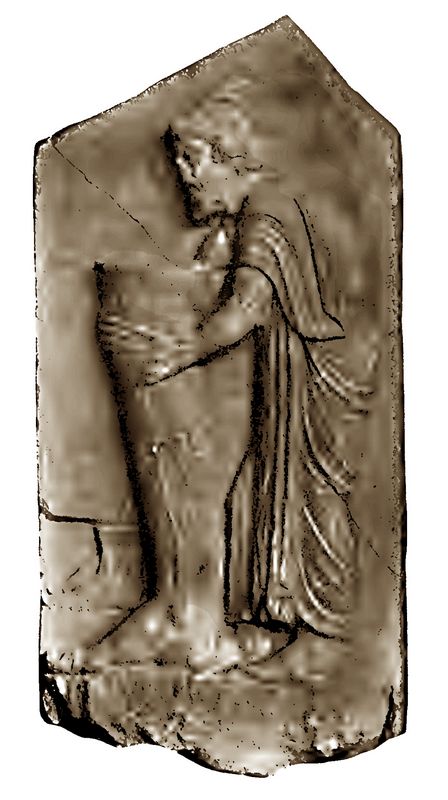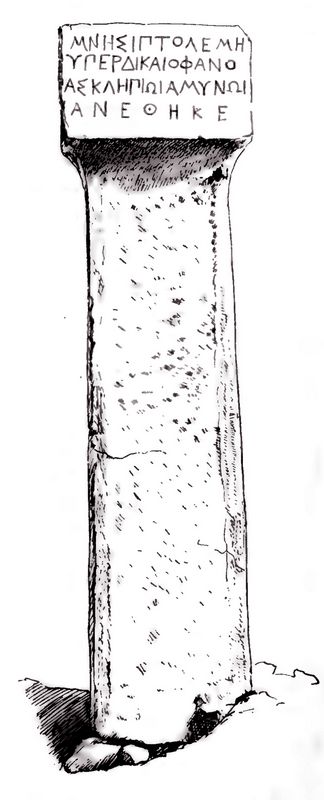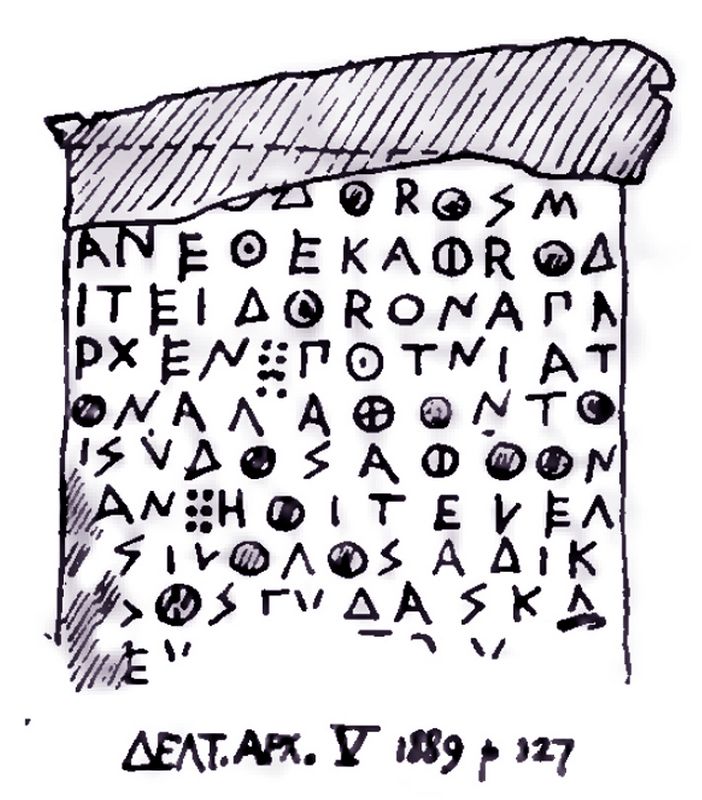|
CHAPTER III
The Sanctuaries that are Outside the Citadel (part 2).
The Amyneion.
The
Amyneion, or sanctuary of Amynos [85], is known to us only through
monumental evidence, brought to light in the recent excavations. Its
discovery is one of the things that make us feel suddenly how much of
popular faith we, relying as we must almost wholly on literature, may
have utterly lost. If
after leaving the precinct of Dionysos in-the-Marshes we follow the
main road for about 35 metres, we come on a precinct (fig.30) of much
smaller size and of quadrangular shape, which abuts on the road and
along the North side of which a narrow foot-path leads up to the
Acropolis. The precinct-walls are of hard blue calcareous stone from
the Acropolis and neighbouring hills, and the masonry is good
polygonal.
Fig.30: Plan of the Sanctuary of Amynos (Ath.Mitt. XXI, 1896 plate xi).
The entrance-gate (A), (p.101) which
has been rebuilt in Roman times, is at the North-West corner. A little
to the East of the middle of the precinct, and manifestly of great
importance, is a well (B). The natural supply of this well was
reinforced by a conduit-pipe, which leads direct into it from the great
water-course of Peisistratos, which will later (p.119) be described.
Near the well are remains of a small herochapel, and within this was
found the lower part of a marble sacrificial table (C), decorated with
two snakes. The masonry of the precinct wall, the well, and the shrine
all point to a date at the time of Peisistratos. Even before the limits
of this precinct were fairly made out the excavators came upon a number
of fragments of votive offerings of a familiar type. Such are reliefs
representing parts of the human body, breasts and the like, votive
snakes, and reliefs representing worshippers approaching a god of the
usual Asklepios type. Conspicuous among these was a fine well preserved
relief (Fig. 31), depicting a man holding ‘a huge leg, (p.102) very
clearly marked with a varicose vein, exactly where, doctors say, a
varicose vein should be. The inscription [86] above the figure is
unfortunately so effaced that no facts emerge save that the dedicator,
the man who holds the leg, was the son of a certain (p.103) Lysimachos,
and was of the deme Acharnae.

Fig.31: Votive relief from Sanctuary of Amynos.
But
now-a-days in the matter of ascription we proceed more cautiously. We
know that votive-reliefs of the ‘ Asklepios’ type are offered to almost
any local hero, that local heroes anywhere and everywhere are
hero-healers [87] . Hence local hero-healers were gradually absorbed
and effaced by the most successful of their number, Asklepios. In
literature we hear little of the hero-cult of an Amphiaraos, but his
local shrine went on down to late days at Oropus. Fortunately in our
precinct we have inscriptions that leave us no doubt. On a stele
[88] (Fig. 32) found there we have an inscription as follows:
(p104)
‘Mnesiptoleme on behalf of Dikaiophanes dedicated (this) to Asklepios Amynos.’

Fig.32: Stele with inscription from Sanctuary of Amynos.
Sophocles
[91] though, to us, he is first in remembrance, comes last in ritual
precedence; Amynos is first. The history of the little shrine is
instructive. Not later than Peisistratos, and how much earlier we do
not know, the worship was set up of a local hero with the title
Protector, Amynos. At some time or other, perhaps shortly after the
pestilence at Athens, which the local Protector had been powerless to
avert, it was thought well to call in a greater Healer-Hero, Asklepios,
who meanwhile had attained in the Peloponnesos to enormous prestige.
The experiment was tried carefully and quietly in the little precinct. Amynos
kept his own precedence. No one’s feelings are hurt; the snake of the
Peloponnesos is merely affiliated to the local Athenian hero-snake, the
same offerings are due to both, the pelanot, the votive limbs. But the
new-comer is too strong; Asklepios waxes, Amynos wanes—into an
adjective. Asklepios outgrows the little precinct and betakes himself
to a new and grander sanctuary on the South slope.
The precinct
and worship of Amynos, though it has no mention in literature, is
preserved to us perhaps through its association (p.105) with
the dominant worship of Asklepios ; but Amynos was probably only one
among many heroes who had their chapels and their family worships
scattered along the main road of the city where countless little
buildings remain unidentified (Fig. 35). If the supposition suggested
above (p. 99) be correct these local heroes must have had choral dances
about their tombs, those choral dances affiliated by the late-comer
Dionysos, and ultimately leading to the development of the drama. At
the festival of the Anthesteria these local ghosts would be summoned
from their tombs on the day of the Pithoigia; on the day of the Chytroi
they would be fed and their descendants would hold a wake with revels
and dancings.
The Sanctuary of the Semnae Theai or Venerable Goddesses.
The site of this sanctuary is practically certain. Euripides [92] in the Electra
makes the Erinyes, when they are abeut to become Semnae, descend into a
chasm of the earth near to the Areopagos. Near to the Areopagos there
is-one chasm and one only, that is the deep fissure on the North-East
side, the spot where tradition has long placed the cave of the Semnae
[93]. A cave they needed, for they were under-world goddesses. Their
ritual I have discussed in detail elsewhere [94]; here it need only be
noted that it was of great antiquity and had all the characteristic
marks of a chthonic cult. As under-world goddesses the Venerable
Ones bore the title also of Arai, Imprecations; they were for cursing
as well as blessing ; the hill it is now generally acknowledged took
its name from them rather than from the war-god Ares. Orestes it will
be remembered [95] came to the Areopagos to be purified from his
mother’s blood, and he found the people celebrating the Choes; he found
them, if our topography be correct, close by, in the precinct of
Dionysos-in-the- Marshes.
The Sanctuary of Aphrodite Pandemos.
Harpocration
[96] in explaining the title Pandemos tells us that Apollodorus in the
sixth book of his treatise About the Gods said that this was ‘the name
given at Athens to the goddess whose worship had been established
(p.106) somewhere
near the ancient agora.’ His conjecture that the goddess was called
Pandemos because all the people collected in the agora need not detain
us, but the topographical statement coming from an author who knew his
subject like Apollodorus, is important. We have to seek the sanctuary
of Pandemos somewhere on or close to the West slope of the Acropolis,
somewhere near the great square which as we shall see (p. 131) stood in
front of the ancient well-house and formed the ancient agora.
Pausanias
[97] mentions the worship of Aphrodite Pandemos in a sentence of the
most tantalizing vagueness. After leaving the Asklepieion he notes a
temple of Themis and in front of it a monument to Hippolytus. He then
tells at length the story of Phaedra and next goes on ‘When Theseus
united the various Athenian demes into one people he introduced the
worship of Aphrodite Pandemos and Peitho. The old images were not there
in my time, but those I saw were the work of no obscure artists.’
Immediately after he passes to the sanctuary of Ge Kourotrophos and
Demeter Chloe and then straight to the citadel.
Of the actual
sanctuary of Aphrodite Pandemos not a trace has been found. From the
account of Pausanias coupled with that of Harpocration we should expect
it to be somewhere below the sanctuary of Ge and above the fountain
Enneakrounos, near which was the ancient agora, and of course outside
the Pelargikon. When the West slope of the Acropolis was excavated [98]
in the upper layers of earth about 40 statuettes of Aphrodite were
found, and these must have belonged to the sanctuary. Inscriptions
[99] relating to her worship were found built into a mediaeval
fortification wall near Beule’s Gate. These, as not being in situ,
cannot be used as topographical evidence, but they give us important
information as to the character of the worship of Pandemos.

‘[...]dorus dedicated me (p.107) to
Aphrodite a gift of first fruits, Lady do thou grant him abundance of
good things. But they who unrighteously say false things and....’
Unfortunately here the inscription breaks off so the scandal will
remain for ever a secret. Aphrodite, it is to be noted, is prayed to as
a giver of increase. She does not seem yet to have got her title of
Pandemos, but as this occurs in the two other inscriptions found with
this one, and they probably all three came from the same sanctuary, this Aphrodite is almost certainly she who became Pandemos.
Fig.33: Insciption from early 5th c. BC dedicated to Aphrodite Pandemos.
The
second inscription (Fig. 34), dating about the middle of the 4th
century B.C., is carved on an architrave adorned with a frieze of doves
carrying a fillet, The architrave is broken midway. Only the left-hand
half is represented in the figure. This inscription [101] again is
partly metrical, forming an elegiac couplet.
Fig.34: Inscription on architrave from 4th c. BC dedicated to Aphrodite Pandemos.
‘This for thee, O great and holy Pandemos Aphrfodite,
We adorn with gifts, our statues.’
Beneath
in prose and in smaller letters come the names of the dedicators.
Pandemos is here quite plainly the official title of the
goddess.
(p.108)
The
third and latest inscription [102] is carved on a stele of Hymettus
marble. It is exactly dated (283 B.c.) by the archon’s name, the elder
Euthios. It records a decree made while a woman called Hegesipyle was
priestess. The decree, which is too long to be here quoted in full,
ordains that the astynomoi should at the time of the procession in
honour of Aphrodite Pandemos ‘ provide a dove for the purification of
the temple, should have the altars anointed, should give a coat of
pitch to the roof and wash the statues and prepare a purple robe.’
Aphrodite
Pandemos was a ‘great and holy goddess,’ giver of increase. She was no
private divinity of the courtesan; the second inscription tells us that
she was worshipped by a married woman, who is her priestess. It is
literature and not ritual that has cast a slur on the title Pandemos;
the state honoured both her and Ourania alike ‘according to ancestral
custom.’ Plato [103] In his beautiful reckless way will have it that
because there are two Loves there are two Goddesses, ‘the elder one
having no mother, who is the Heavenly Aphrodite, the daughter of
Ouranos; to her we give the title Ourania, the younger, who is the
daughter of Zeus and Dione, and her we call “ Of-all-the-People,”
Pandemos.’
The real truth was that Aphrodite came to the Greeks
from the East and like most Semitic divinities she was not only a
duality but a trinity.
When Pausanias [104] was at Thebes he saw
the images of this ancient Oriental trinity and he knew whence they had
come. ‘There are wooden images of Aphrodite at Thebes so ancient that
it is said they were dedicated by Harmonia and that they were made out
of the wooden figure-heads of the ships of Cadmus. One of them is
called Heavenly, another Of-all-the-People, and the third the
Turner-Away.’ The threefold Aphrodite came from the Semitic East
bearing three Semitic titles: she was the Queen of Heaven [105], she
was the Lady of all the People, Ourania and [p.109] Pandemos,
what the third title was which the Greeks translated into Apostrophia
we do not know; as already noted it took slight hold. At Megalopolis
[106] we see how the third title of. the trinity faded. There close to
the house where was an image of Ammon made like a Herm and with the
horns of a ram, there—significant conjunction—was a sanctuary of
Aphrodite in ruins, with the front part only left and it had three
images, ‘one named Ourania the other Pandemos, the third had no
particular name. So it was that the Greeks lost the trinity and kept,
all they needed, the duality.
The
Greeks themselves always knew quite well whence came their Heavenly
Aphrodite, she of Paphos, and she of Kythera. Herodotus [107] is
explicit. He is telling how some of the Scythians in their passage
through Palestine from Egypt pillaged the sanctuary of Aphrodite
Ourania at Ascalon. ‘This sanctuary, he says, ‘I found on enquiry is
the most ancient of all those that are dedicated to this goddess, for
the sanctuary in Cyprus had its origin from thence, as the Cyprians
themselves say, and that in Kythera was founded by Phenicians who came
from this part of Syria. Pausanias [108] says ‘the first to worship
Ourania were the Assyrians, next to them were the dwellers in Paphos of
Cyprus, and the Phenicians of Ascalon in Palestine. And the inhabitants
of Kythera learnt the worship from the Phenicians.’
The
Oriental origin [109] of Ourania, Queen of Heaven, the armed goddess,
the Virgo Caelestis, was patent to all; but Aphrodite in her more human
earthly aspect, as Pandemos, goddess of the (p.110) people and of
all increases,as so like Kourotrophos, like Demeter, that she might
easily be thought of as indigenous. Yet her ritual betrays her. For the
purification of her sanctuary we have seen there was ordered a dove.
Instinctively we remember that when Mary Virgin [110] went up to the
temple of Jerusalem for her purification she must take with her ‘a pair
of turtle-doves or two young pigeons. In the statuettes of Paphos,
Aphrodite holds a dove in her hand; the coins of Salamis in Cyprus are
stamped with the dove [111]. At the Phenician Eryx when the festival of
the Anagogia [112] came round, and Aphrodite Astarte went back to her
home in Libya, the doves went with her, and when they came back at the
Katagogia, a white multitude, among them was one with feathers of red
gold, and she was Aphrodite.
85. Ath. Mitt. 1896, XXI, p. 286, pl, xi.
86. ων τευξα-
—wy σεμνοτάτην.
Λυσιμαχι]δῆς Λυσιμάχου ᾿Αχαρνε[ύς, See Dr Koerte’s discussion of the relief, A, Mitt. 1898, p. 235,
87. See my Prolegomena, p. 349.
88. Koerte, A. Mitt, 1896, xxi. p. 295 Μνησιπτολέμη ὑπὲρ Δικαιοφάνου[5 ] ᾿Ασκληπιῷ ᾿Αμύνῳ ἀνέθηκε.
89.
Koerte, op. cit. p. 299... δεδόχθαι τοῖς ὀργεῶσι ἐπειδή εἶσιν ἄνδρες
ἀγαθοὶ περὶ τὰ κοινὰ τῶν ὀργεώνων τοῦ ᾿Αμύνου καὶ τοῦ ᾿Ασκληπιοῦ καὶ
τοῦ Δεξίονος....
90. line 15 ἀναγράψαι δὲ τόδε τὸ ψήφισμα ἐν
στήλαις λιθίναις δυοῖν καὶ στῆσαι τὴν μὲν ἐν τῷ το] Δεξίονος ἱερῷ τὴν
δὲ [ἐν τῷ το(0)᾿Αμύνου καὶ ᾿Ασκληπιοῦ.
91. the worship of Sophocles, see my Prolegomena, p. 346.
92. Eur. El. 1271.
93. Myth. and Mon. Anc. Athens, 11. p. 554.
94. Prolegomena, pp. 239—253.
95. Athen. x. 437.
96.
Harp. s.v. Πάνδημος "Agpodirn... ᾿Απολλόδωρος ἐν τῷ περὶ Θεῶν πάνδημόν
φησιν ᾿Αθήνῃσι κληθῆναι τὴν ἀφιδρυθεῖσαν περὶ τὴν ἀρχαίαν ἀγοράν....
97. Paus. I. 22. 3.
98. Dorpfeld, A. Mitt. 1896, p. 511.
99. Foucart, Bull. de Corr. Hell. 1889, p. 157.
100. The facsimile is from Δελτίον 1889, p. 127. The inscription reads as follows:
...]dwpos μ᾽ ἀνέθηκ᾽ ᾿Αφροδίτην δῶρον ἀπαρχήν.
Πότνια τῶν ἀγαθῶν rat] σὺ δὸς ἀφθον[(]αν.
οἵ τε λέγίου]σι λόγους ἀδίκως ψευδᾶς K...EK...
It is discussed with the two that follow by Mr Foucart, Bull. de Corr. Hell. 1889, p. 157.
101. Τόνδε σοὶ, ὦ μεγάλη σεμνὴ Πάνδημε ᾿Αφρ[οδίτη]
[κοσἹμοῦμεν δώροις εἰκόσιν ἡμετέραις
᾿Αρχῖνος ᾿Αλυπήτου Σκαμβωνίδης, Μενεκράτεια Δεξικράτους
Ἰικαριέως θυγάτηρ, ἱέρεια τῆς [’Adpodirys],...
. AleEtxparous ᾿Ικαριέως θυγάτηρ, ᾿Αρχίνον δὲ μήτηρ.
For discussion of this inscription and the nature of the building dedicated, see
Dr Kawerau, ‘Die Pandemos-Weihung auf der Akropolis’ (A, Mitt, 1905), which
through his kindness reached me after the above was written.
102. ἡ πομπὴ τῆι ᾿Αφροδίτηι ret ἸΠανδή-
μωι παρασκευάζειν εἰς κάθαρσιν
τ]οῦ ἱεροῦ περιστέραν καὶ περιαλε[ϊ-
Wat] τοὺς βωμοὺς καὶ πιττῶσαι τὰς
ὀροφὰΞ] καὶ λοῦσαι τὰ ἔδη παρασκευ-
άσαι δὲ κα]ὶ πορφύραν ὁλκὴν + + ["-
See B.C.H. 1889, p. 157, and Myth, and Mon. Anc. Athens, p. 331.
103. Plat. Symp. 180p. For Aphrodite Ourania, see Myth. and Mon. Anc. Athens,
p. 211.
104. Paus. IX. 16, 3.
105.
I follow M. Victor Bérard, Origine des cultes Arcadiens, p. 142.
Ourania is ‘Queen of Heaven,’ xxxxxxxxxxx, as in the Hebrew scriptures,
Jerem. vii. 18, xliv. 18—20. Pandemos is yyyyy, lady of the land. I
have ventured above, p. 54, to suggest that to the armed Ourania, the
Virgo Caelestis, we owe at least some
elements in the armed Athena.
106. Paus, VIII. 32. 2.
107. Herod. I. 105. The name Kythera is Semitic ((9N5); see M. Victor Bérard,
Les Phéniciens et V Odyssée, p. 427. Kythera means a headdress, a tiara, and its
Greek ‘ doublette’ is Skandeia.
108. Paus, I. 14. 7.
109.
We have incidentally curious evidence of the association of
Kourotrophos with the Oriental Aphrodite. An inscription (C.I.A. ur.
411) found on a Turkish wall near the temple of Nike mentions the
entrance to a chapel of Blaute and Kourotrophos (εἴσοδος πρὸς σηκὸν
Βλαύτης καὶ Kouporpépov). Lydus (de Mens. τ. 21), on the authority of
Phlegon, tells us that Blatta was ‘a title of Aphrodite among the
Phenicians’ (καὶ βλάττα δέ, ἐξ ἧς τὰ βλάττια λέγομεν, ὄνομα ᾿Αφροδίτης,
ἐστι κατὰ τοὺς Φοίνικας ὡς ὁ Φλέγων ἐν τῷ περὶ ἑορτῶν φησί). He does
not tell us,—what is obvious enough,—that Blaute and Blatta are Greek
attempts to reproduce Baalat . (Ὁ). Blaute is but Aphrodite-Pandemos,
Lady, Baalat of the People.
110, Luke ii. 24.
111. Mr E. Babelon, Monnaies des Phéniciens, cxxv.
112. Ael. Nat. Anim. 1v. 2; see M. Victor Bérard, Cultes Arcadiens, p. 106.
[Continue to Chapter 4]
[Return to Table of Contents]
|
|